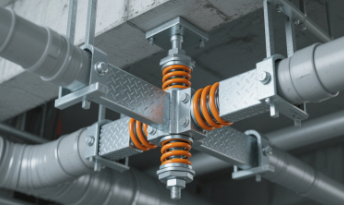Like in any field of construction, securing the structural integrity of installations is critical in the building and engineering world. Seismic brackets are critical components for providing the necessary support and stability not just to ventilation installations but to any building that is located in seismically active zones. By the end of this article, you'd understand the critical importance of seismic brackets, their working principles and how they contribute to effectively ventilating the building and safeguarding its operations.
Understanding Seismic Brackets
Seismic brackets are discrete pieces of hardware that are meant to hold systems such as ventilation ducts and other peripherals to protect them from seismic movements. Seismic brackets like all other brackets serve a singular purpose for maintaining the functionalities of any ventilation or seismic brackets. In any building located in highly active seismic zones, investing into building ventilation systems is evacive but necessary.
The Right Kind of Support for Ventilation Systems
Without a properly-maintained ventilation system, ensuring high quality indoor air, optimal temperature control, and overall comfort for the occupants can be near impossible. Moreover, ventilation systems can be prone to damage during seismic events. Duct seismic brackets help to prevent damage by providing solid anchoring points to ventilation ducts, ensuring they do not sway or break during seismic events. This helps to maintain the overall integrity and the safety of the building while protecting the ventilation system.
The Function of Seismic Brackets
Ventilation systems can be particularly useful during periods of high seismic activity. Duct seismic brackets aid in this functionality during vents of high activity by anchoring specific components of a building to a specific ventilation system, such as ductworks. They are placed in the most critical areas along the ductworks to guarantee equal ventilation during quakes. By ensuring that ventilation systems are able to fully function during quakes, seismic brackets help to maintain overall duct functionality.
Selecting The Right Seismic Brackets
While choosing seismic brackets to be used for ventilation systems, multiple aspects should be taken into account. The building design, seismic risks of the given area, as well as the size and weight of the ventilation parts will determine the bracket design. It is always wise to consult an engineering specialist to ascertain that the right seismic brackets supporting the installation are selected.
Recent Developments and Next Steps
Focus on construction innovations and new technologies is shifting to the design and building of safer structures. Brackets that are specially designed to withstand seismic activity are being manufactured due to advances in construction materials and design. In addition to that, the building codes are evolving, making the installation of the seismic brackets for the new building designs mandatory. The modern ventilation systems are predicted to be more in demand as the risks for seismic activities become more evident.
As stated before, seismic brackets are important for the safety and functionality of ventilation systems, especially in earthquake-prone regions. They protect and support ventilation systems so that the safety of the building and its occupants is ensured. With the development of the industry, the need for the ventilation systems will be in greater demand, making construction practices more important.

